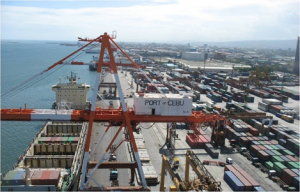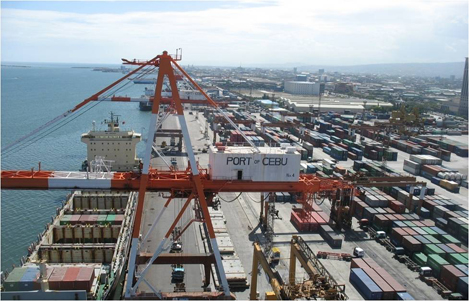 Cargo traffic at Cebu International Port (CIP) continues to grow, recording 16.868 million metric tons (mmt) for the first half of 2014, up 14.5% from 14.728 mmt in the same period last year.
Cargo traffic at Cebu International Port (CIP) continues to grow, recording 16.868 million metric tons (mmt) for the first half of 2014, up 14.5% from 14.728 mmt in the same period last year.
Of the total, domestic cargo accounted for 12.39 mmt, or 73.5%, and was 15.63% higher than the 10.715 mmt of January to June 2013.
Foreign cargo, on the other hand, contributed 26.5%, or 4.477 mmt, to the total volume in the first half, an increment of 5.9% from 4.227 mmt in the same period last year.
Container traffic likewise rose from January to June, posting a 10.38% hike to 341,511.75 twenty-foot equivalent units (TEUs) compared with 309,403.75 TEUs in the same period last year.
Around 60.4% of the total containerized traffic was domestic cargo, registering 206,158 TEUs, or 9.9% up from 187,502.5 TEUs a year earlier.
Contributing 39.6%, or 135,353.75 TEUs, was foreign cargo, which showed an increment of 11.03% from 121,901.25 TEUs logged in the first half of 2013.
About 54,906 vessels called at the Cebu port in the first half of 2014, but no comparative figures were available for the same period of the preceding year. However, 30,220 ship calls were recorded during the second quarter of 2013.
Passenger volume, meanwhile, declined in the first six months by 5% to 8.671 million from 9.125 million in the same period last year.
For the first half, the Cebu Port Authority (CPA) posted P611.19 million in revenue, the figure higher than the P460 million target for the period. The port authority aims to generate P920 million for the full year, or 2.1% more than the P900.9 million it recorded in 2013.
On port facilities, CPA has added 129 meters to its berth for the roll-on/roll-off operations, and still has 96 meters to go to complete the target of 225 meters for 2014.
CPA likewise increased the seating capacity at its terminal with an additional 1,270 seats, only 251 seats shy of the 1,512-seat target.
Loan for berth upgrade frozen
Upgrading of CIP’s berths and dredging of Mactan Channel remain pending due to a delay in the release of a loan for the project from the Development Bank of the Philippines.
In his first-half report, CPA general manager Edmund Tan said that the P570-million loan was put on hold due to new requirements from the Monetary Board, “causing the suspension of the implementation of the project.”
He added that the new requirement for the release of the loan is waiting for the confirmation of Secretary Joseph Emilio Abaya of the Department of Transportation and Communications.
When the project resumes, Tan said CIP only needs to complete minus 8.5 meters of draft, considered low compared to other ports.
Tan noted that in several instances, CPA has had to turn away vessels interested to dock at the port because of the draft limitation, representing opportunity losses in revenue and operational efficiency.
Cebu has own congestion, truck ban blues
Meanwhile, truck bans and port congestion are not only the exclusive problems of Metro Manila.
Tan said CPA has conducted several consultative meetings on these issues in Cebu and has “always concluded (that they bring) inconveniences to the public but (that they) are out of CPA’s control, whether in full or in part.”
Such inconveniences include the delay in the withdrawal of imports at CIP, Tan said.
He said even non-storage areas are now being used for storage, creating a problem for CPA because the space for cargo movement has become very limited. “And in general, this is perceived as port inefficiency,” Tan said.
Furthermore, Mandaue City has implemented its own truck bans, limiting the travel or operational time of truckers withdrawing cargoes from or delivering them to the port.
“There are certain times of the day wherein traffic jams of roads leading to or within the port area are heavy,” Tan said, adding that on the contrary, during a scheduled truck ban, port operations are expected to be light or sometimes idle.
The port authority earlier said it is working on transferring its international container terminal to Tayud, Consolacion to cope with the increase in the volume that the port handles. – Roumina Pablo





